August in Malaga means one thing - the Feria of Malaga. Ten long hot days full of music, dancing and fun from dawn until dusk. During the days of the Feria, the characteristic pink and white spotted Cartojal bottles are passed from hand to hand, chilled white wine is poured into traditional fuchsia pink cups, toasts are made and the laughter is endless. For years, Cartojal has been the drink of choice for the revellers of Malaga’s Feria.
Today we meet the family behind Malaga’s Feria favourite wine, their history, stories and traditions and also some background on how the Cartojal wine came to be.
The Beautiful Views of The Vista Hermosa Estate
Our visit to the Vista Hermosa estate started on a long, dirt road lined on one side by ancient olive trees and on the other side by a motorway which runs down to the village of Fuente de Piedra. The sun was high and relentlessly heating up the earth, there wasn't even the slightest breeze to provide relief.
Vista Hermosa means “beautiful view” in Spanish and you can instantly see why this estate has earned such a name. It's now home to one of the most famous vineyards in Spain - the Malaga Virgen Bodegas.
The flagship product of this vineyard is the sweet wine called Malaga Virgen. The vineyard also produces a huge selection of other products such as the Pernales red wines, excellent quality brandy, vermouth and Moscatel white wines. This vineyard is a paradise for those who dream about strolling under the hot Andalusian sun, along endless paths between green, juicy grapevines.
Exporting Malaga’s Wine
The Malaga Feria is considered by many to be city’s biggest and craziest street party. The streets are filled with women in typical flamenco dresses, each with a fan in one hand and in the other, a narrow glass of cool white wine which radiates a sweet, narcotic aroma.
Cartojal wine was originally produced for export, but the people of Malaga soon fell in love with it and today, this sweet beverage is at the core of the Malaga Feria.
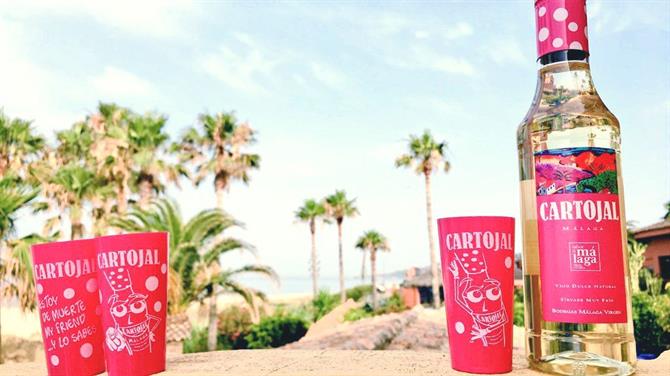
“The production of Cartojal began at the request of a foreign company who were responding to the increased demand for a sweet, wine white," explains Lucas Bricout de Burgos, Head of Export and Marketing at Malaga Virgen Bodegas. "We began producing the wine and exporting it under a different name. 25 years ago, we noticed that huge quantities of wine were consumed during the Feria but also, that none of it was locally produced,” He continues, “it’s a wine of great quality which we wanted to be enjoyed during the Feria.”
Cartojal is definitely quite different from the other wines produced by the Malaga Virgen Bodegas. The wine is made from the Moscatel de Alejandria grape, a grape native to Malaga which is grown in the Axarquia region. The other grape used to make Cartojal is the Moscatel Morisco grape which is grown in the vineyard of Fuente de Piedra, Malaga. Interestingly, the harvest of these grapes takes place in the middle of the night, to avoid the intense heat of the Andalusian days.
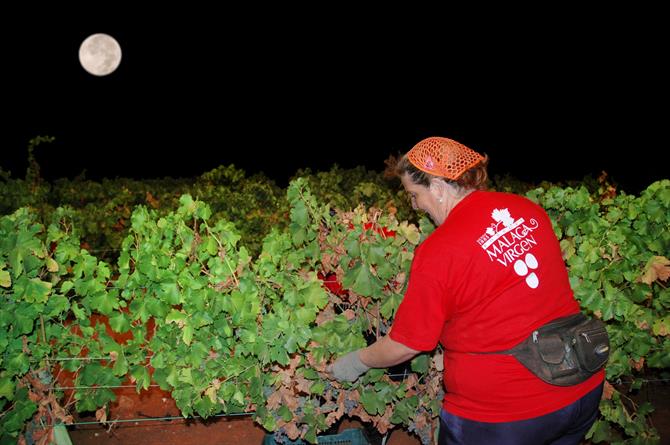
For foreigners, the name Cartojal might sound quite exotic, but not for the locals. Cartaojal is a village located just a few kilometres from the vineyard, where just a few years ago the grape dehydration process or paseras, took place. The grapes were spread out and completely dried under the hot sun, in order to increase the sugar levels in the grape.
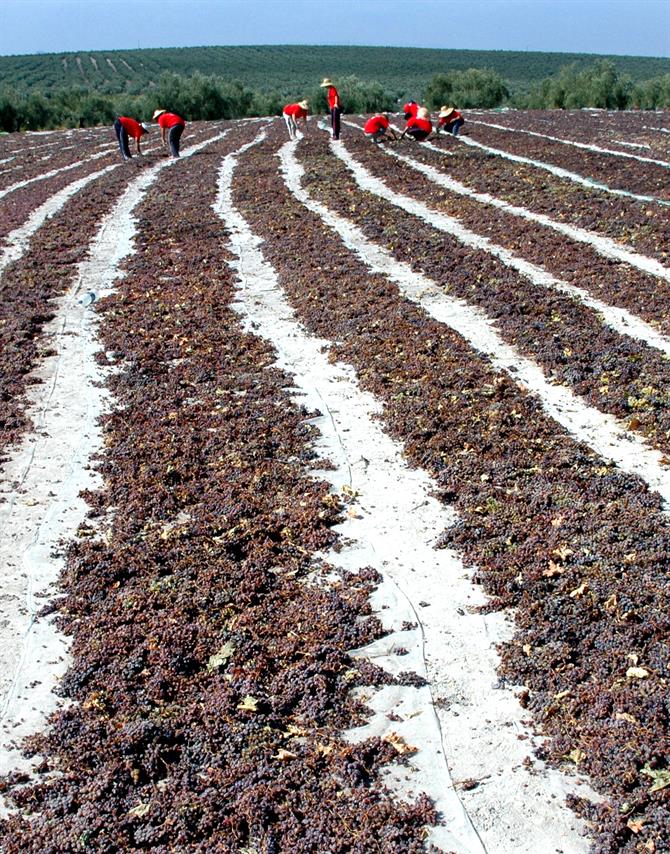
The unconventional method for preparing the grapes reflects this wine’s unique flavour and aroma. Wine specialists describe the colour of the wine as a light yellow with shades of pale green. It has a delicate floral aroma with hints of honey and citrus, which makes the wine perfect to drink when chilled. A more experienced nose will also be able to smell a gentle aroma of smoke.
Enjoy Cartojal on a Malaga Holiday
If you intend on serving a sweet white wine during your holiday in Malaga, when the temperature on the streets reaches 35 degrees, you should definitely chill it. During the summer, Cartojal is served at between 6-8 degrees which is when it tastes its best. During the Feria consumers want cool, light refreshments, so seeing people picking cold bottles of Cartojal out of their pull-along freezers is a very common sight.
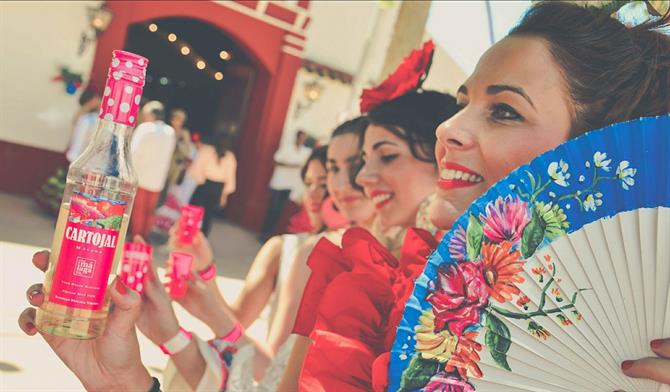
The uncommon choice of using plastic bottles to package this wine was anything but random. Due to the fact that Cartojal is mainly drunk on the streets, producers decided it would be safer to make the bottle out of plastic ensuring that during the festivities, streets stay free of broken glass. Regardless, the law in Malaga actually states that drinking from glass bottles in the streets is illegal, so 90% of all Cartojal produced goes into plastic bottles and just 10% to glass.
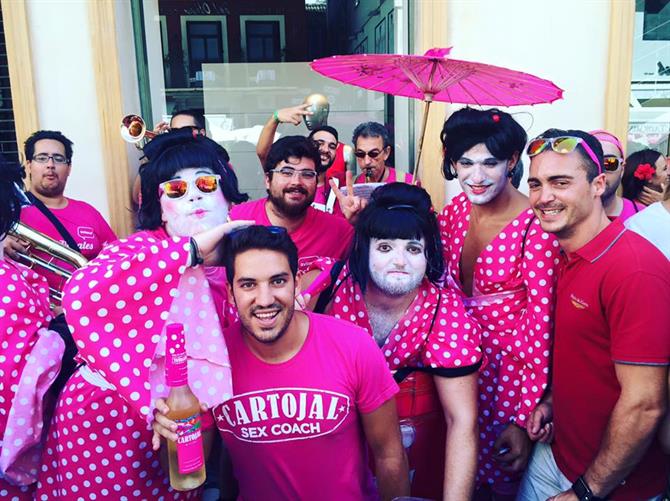
The most eye catching thing about the Cartojal bottles is their bright, fuchsia pink colour.
Lucas Bricout de Burgos explains: “We decided on the fuchsia pink colour because it’s bright and draws attention whilst evoking the happy feelings of the holiday - feelings of joy and fun. The white dots make reference to typical Andalusian folklore, where they often appear on traditional costumes. Each Andalusian province has it’s own colours, which are displayed during the Feria. In Seville, it’s red and black, in Cordoba green and white and in Malaga we have introduced fuchsia pink and white.”
Every year the Malaga Virgen Bodegas produce about half a million bottles of Cartojal which will appear both during the festivities in Malaga and other places across Andalusia; the pink capped bottle is always accompanied by small, pink plastic cups.
Malaga Virgen Bodegas - 130 Years of Family History
“The vineyard was founded by my great grandfather Salvador Lopez Lopez in 1885,” explained Piluca de Burgos, Head of Administration and Finance at Malaga Virgen Bodegas, “in the aftermath of a grape phylloxera plague which destroyed his vines, he decided to settle in the centre of Malaga and establish a vineyard for producing grapes and making wine. During our family history, we have experienced some complicated and difficult times - the Spanish Civil War for example - which left us completely deprived of supplies.”
She continues: “The world wars made the export of Malaga's wines chaotic and almost impossible. In the 1960s we experienced a boom in the domestic market during which both the Malaga Virgen wines and our other Kina San Clemente wines sold very well. Since the 60s, we have continued to produce and export more wines, brandy, vermouth and even vinegar.”
Today, the Malaga Virgen Bodega stands on 12,000 square metres and has 120 hectares of vineyards in the area of the Fuente de Piedra and another 230 hectares in other parts of Andalusia. It has the name of Malaga Denominación de Origen, which is a very prestigious title given to vineyards and wines of the highest quality. It is one of the oldest titles in Spain and in order for a vineyard to earn this name, it must meet a number of very stringent requirements both in breeding and production.
Wine lovers can visit the Malaga Virgen Bodegas in Fuente de Piedra and see first hand, how one of the most popular and well-known wines in Andalusia is made.
Visits to the Malaga Virgen Bodegas must be booked by phone or email:
Telephone: (+34) 952 319 454
E-mail: enoturismo@bodegasmalagavirgen.com
The best way to familiarise yourselves with the treasures of Andalusia is to become immersed in the lively culture of this place, rent a holiday home in Malaga or a nearby area and discover all the secret places that are waiting to be discovered.
